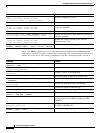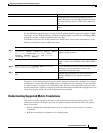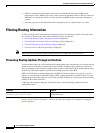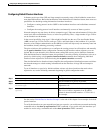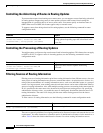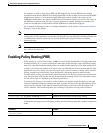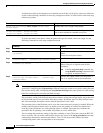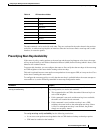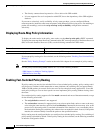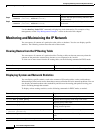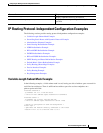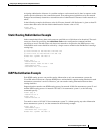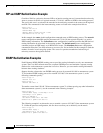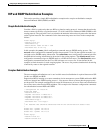
Configuring IP Routing Protocol-Independent Features
Enabling Policy Routing (PBR)
IPC-376
Cisco IOS IP Configuration Guide
• The directly connected next hop must be a Cisco device with CDP enabled.
• It is not supported for use in conjunction with dCEF, due to the dependency of the CDP neighbor
database.
If you want to selectively verify availability of only some next hops, you can configure different
route-map entries (under the same route map name) with different criteria (using access list matching or
packet size matching), and use the set ip next-hop verify-availability configuration command
selectively.
Displaying Route-Map Policy Information
To display the cache entries in the policy route cache, use the show ip cache policy EXEC command.
To display the route map Inter Processor Communication (IPC) message statistics in the Route Processor
(RP) or Versatile Interface Processor (VIP), use the following command in EXEC mode:
If you want policy routing to be fast switched, see the following section “Enabling Fast-Switched Policy
Routing.”
See the “Policy Routing Example” section at the end of this chapter for an example of policy routing.
Note For new policy-based routing (PBR) features in 12.4, see the following modules:
- PBR Support for Multiple Tracking Options
- PBR Recursive Next Hop
Enabling Fast-Switched Policy Routing
IP policy routing can now be fast switched. Prior to fast-switched policy routing, policy routing could
only be process switched, which meant that on most platforms, the switching rate was approximately
1000 to 10,000 packets per second. Such rates were not fast enough for many applications. Users that
need policy routing to occur at faster speeds can now implement policy routing without slowing down
the router.
Fast-switched policy routing supports all of the match commands and most of the set commands, except
for the following restrictions:
• The set ip default command is not supported.
• The set interface command is supported only over point-to-point links, unless a route cache entry
exists using the same interface specified in the set interface command in the route map. Also, at the
process level, the routing table is consulted to determine if the interface is on a reasonable path to
the destination. During fast switching, the software does not make this check. Instead, if the packet
matches, the software blindly forwards the packet to the specified interface.
Policy routing must be configured before you configure fast-switched policy routing. Fast switching of
policy routing is disabled by default. To have policy routing be fast switched, use the following command
in interface configuration mode:
Command Purpose
Router# show route-map ipc
Displays the route map IPC message statistics in the RP or VIP.



